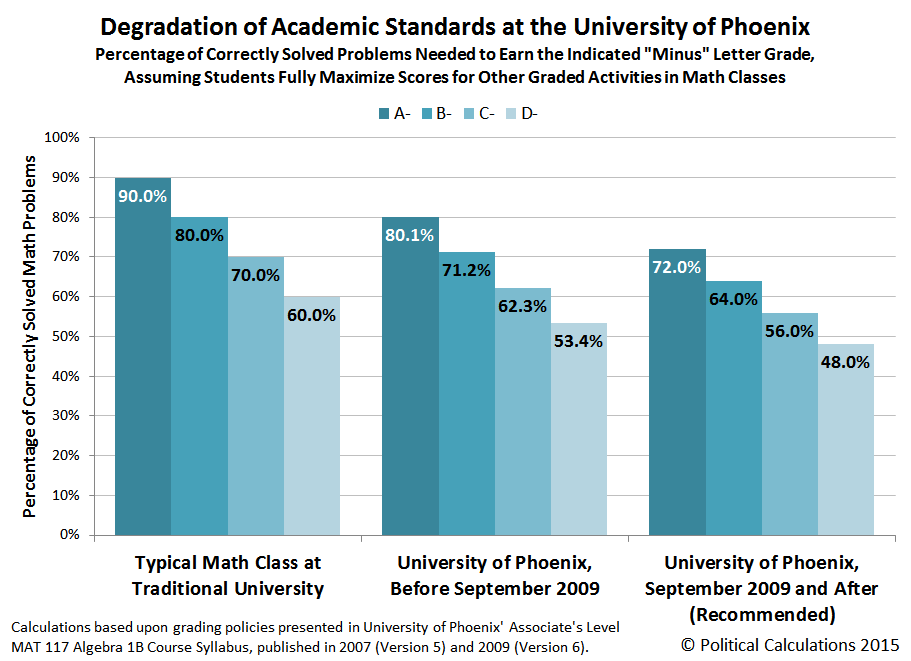In 2009, the University of Phoenix degraded its academic standards for assessing student performance in its math classes. The University of Phoenix achieved this result by recommending to its instructors that they decrease the emphasis that they had previously mandated for students to demonstrate their proficiency in solving assigned problems in favor of increasing the weighting of the subjective evaluation of student participation in class discussions in determining student grades.
Our chart below, which we based on information contained within different versions of the course syllabus for a University of Phoenix Algebra class that captured these changes, graphically reveals how those changes would effectively inflate student grades.
We wondered to what extent similar practices that would result in grade inflation in math classes might have been implemented at other accredited colleges and universities. In the table below, we've presented the relative weighting that subjective, non-math related criteria has upon determining the grade that a student might earn at the indicated institution, based on the course syllabii they have published for their own math classes, which we've linked in the table. We then ranked them in order from best to worst....
| Grade Inflation in College Algebra, Ranked from Best to Worst at Selected Colleges and Universities Relative Weighting of Criteria Other Than Demonstrated Proficiency in Correctly Solving Assigned Problems for Determining Course Grade | ||||
|---|---|---|---|---|
| College or University (Click link for syllabus) | Discussion & Participation, or Attendance [Non-math] | Homework Assignments [Math] | Quizzes & Tests [Math] | Final Exam [Math] |
| University of Houston | 0% | 10% | 75% | 15% |
| Odessa College | 0% | 20% | 50% | 30% |
| Indiana State University | 0% | 25% | 45% | 30% |
| Penn State University | 0% | 15% | 55% | 30% |
| University of Massachusetts | 0% | 70% | 0% | 30% |
| DeVry University | 5% | 15% | 40% | 40% |
| Louisiana State University | 5% | 15% | 55% | 25% |
| Florida Atlantic University | 10% | 10% | 60% | 20% |
| University of Phoenix (Before September 2009) | 12% | 40% | 24% | 24% |
| University of Phoenix (September 2009 to Present) | 22% | 30% | 24% | 24% |
Some interesting takeaways from what we found in our analysis:
- We had expected that for-profit universities like the University of Phoenix would occupy the bottom of the list. Instead, we were surprised to find that the other for-profit institution for which we obtained a math course syllabus, DeVry University, would actually rank near the top, if not at the very top. The surprising reason for that outcome? Even though 5% of a DeVry's student's grade is based on the non-math related criteria of attendance, the for-profit university requires that students demonstrate that they are proficient enough to earn 80% of the points possible in their math classes before being allowed to progress to more advanced classes. For all the universities listed, that is by far the most demanding requirement that a student must satisfy to obtain a passing grade.
- At least one public, state-funded university, Florida Atlantic University, has academic standards similar to what the University of Phoenix had before September 2009.
- Louisiana State University, has a course syllabus that clearly reveals the very low standard needed to earn points attending class....
You will receive a participation grade for each class meeting. You must attend for 50 minutes, take notes, pay attention, and stay awake to earn a grade of 100%. If you fail to meet this requirement throughout the 50-minute class meeting, you will receive a grade of 0% for that class meeting.
And even with that competing standard for low academic performance, when it comes to math, the post-2009 Univerity of Phoenix is still at the bottom of the academic barrel by a pretty wide margin.
Labels: education, math, quality
Welcome to the blogosphere's toolchest! Here, unlike other blogs dedicated to analyzing current events, we create easy-to-use, simple tools to do the math related to them so you can get in on the action too! If you would like to learn more about these tools, or if you would like to contribute ideas to develop for this blog, please e-mail us at:
ironman at politicalcalculations
Thanks in advance!
Closing values for previous trading day.
This site is primarily powered by:
CSS Validation
RSS Site Feed
JavaScript
The tools on this site are built using JavaScript. If you would like to learn more, one of the best free resources on the web is available at W3Schools.com.
